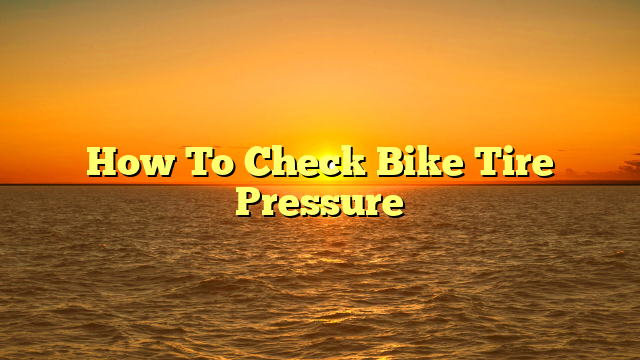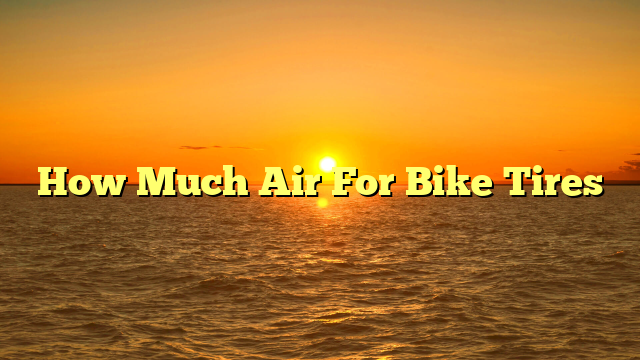As a cyclist, it’s essential to check your bike tire pressure regularly.
Proper tire pressure not only ensures that your ride is smooth and comfortable but also improves the lifespan of your tires.
Riding on underinflated tires can cause them to wear out faster, while overinflated tires reduce your bike’s stability and increase the risk of a blowout.
In this article, I’ll guide you through the steps of checking your bike tire pressure to ensure that you’re riding safely and efficiently.
Before we get started, you’ll need a few tools.
You’ll need a tire pressure gauge, which is an inexpensive tool that measures the air pressure in your tires.
You’ll also need a pump to inflate your tires if necessary.
Most bike pumps come with a gauge, but if yours doesn’t, you’ll need to purchase one separately.
Once you have these tools, you’re ready to start checking your tire pressure.
Table of Contents
Key Takeaways
- Proper tire pressure is crucial for safety and a smooth ride.
- Use a quality tire pressure gauge and check tire pressure when the tires are cool.
- Recommended tire pressure can be found in the manufacturer’s specifications or tire ratings.
- Check tire pressure at least once a week and invest in your own gauge as gas station gauges may not be accurate.
The Importance of Proper Tire Pressure
Don’t underestimate the importance of keeping your bike tires properly inflated with the right amount of pressure!
There are several benefits of maintaining the proper tire pressure, such as better handling, improved fuel efficiency, and longer tire life.
When your tires are inflated to the recommended pressure, they will provide a stable and comfortable ride, while also reducing the risk of getting a flat tire or damaging your rims.
On the other hand, the consequences of underinflation can be severe.
When your tires are not properly inflated, they will wear out faster and become more susceptible to punctures and blowouts.
Additionally, your bike’s handling will be compromised, making it more difficult to control and increasing the risk of accidents.
In the worst-case scenario, a severely underinflated tire can cause a crash, putting you and others in danger.
Therefore, it’s essential to check your bike tire pressure regularly and make sure it’s within the recommended range.
Gather Your Tools
First, you’ll need to grab a few tools to make sure your ride is smooth and safe.
Proper inflation and tire maintenance are essential for bike safety, and checking your tire pressure is a crucial part of it.
Here are the tools you’ll need:
| Tool | Purpose |
|---|---|
| Tire gauge | Measures tire pressure |
| Pump | Adds air to the tires |
| Valve tool | Removes the valve cap, and can help loosen a stuck valve |
| Rags | Cleans off dirt and debris from the valve and tire |
Once you’ve gathered your tools, make sure you’re working in a well-lit area, and that your bike is on level ground.
Before checking the tire pressure, make sure your tires are cold.
If you’ve been riding your bike, wait a few hours for the tires to cool down to an ambient temperature.
Using the valve tool, remove the valve cap from the tire.
Press the tire gauge onto the valve stem, making sure it’s aligned properly.
You should hear a hiss of air as the gauge takes the reading.
Check the pressure against the recommended level for your bike, and if it’s low, use the pump to add air until the pressure is correct.
Check the pressure again to make sure it’s at the right level, and then replace the valve cap.
Repeat the process for the other tire.
Proper tire pressure is essential for a smooth and safe ride, so make sure to check it regularly.
Determine the Recommended Pressure
To determine the recommended pressure for your bike tires, you’ll need to consult the manufacturer’s specifications and use a tire gauge to measure the current air level.
The recommended pressure is usually expressed in pounds per square inch (PSI) and can vary depending on the type of bike and tire you have.
It’s important to note that over-inflating or under-inflating your tires can affect your bike’s performance and safety, so it’s crucial to get the pressure right.
To calculate the appropriate PSI for your bike tires, you’ll need to understand tire ratings.
The ratings are typically printed on the tire’s sidewall, and they indicate the maximum load capacity and inflation pressure for the tire.
You should always inflate your bike tires to the recommended PSI as listed in the manufacturer’s specifications or tire ratings.
By doing so, you’ll ensure that your bike performs at its best and that you remain safe while riding.
Check the Tire Pressure
Make sure you’re riding with confidence and maximum performance by ensuring your bike’s tires are properly inflated.
Here’s how to accurately measure tire pressure and avoid common mistakes when checking tire pressure:
- Use a quality tire pressure gauge to get an accurate reading.
Digital gauges are preferred over analog gauges because they’re more precise.
- Check the pressure when the tires are cool before you ride.
The heat generated during riding can increase the tire pressure, resulting in an incorrect reading.
- Remove the valve cap and press the gauge onto the valve stem.
Hold it firmly in place until the gauge stops moving and then read the pressure.
- If the pressure is too low, use a pump to add air slowly until you reach the recommended pressure.
If the pressure is too high, use the gauge to release some air until you reach the recommended pressure.
- Finally, replace the valve cap to help keep out dirt and moisture.
Common mistakes to avoid when checking tire pressure include not using a gauge, relying on visual inspection, and not checking the pressure regularly.
By following these steps, you can ensure your bike’s tires are properly inflated, which not only improves your ride but also increase the lifespan of your tires.
Adjusting the Pressure
You’ll want your ride to be smooth and comfortable, so imagine yourself adjusting the air levels in your tires to achieve just the right amount of bounce in your step.
Correct technique is crucial when adjusting tire pressure.
First, unscrew the valve cap and attach the tire pressure gauge.
Apply pressure to the gauge until the reading stabilizes.
If the pressure is too low, use a pump to add air until it reaches the recommended level.
If the pressure is too high, use the gauge to release some air until it reaches the recommended level.
Common mistakes when adjusting tire pressure include not using a tire pressure gauge, using an inaccurate gauge, or not checking the recommended pressure levels for your bike.
These mistakes can have a significant effect on bike performance.
If your tire pressure is too low, it can cause the tires to wear out faster and make your ride feel sluggish.
If the pressure is too high, it can make the ride feel harsh and increase the risk of a blowout.
By using the correct technique and avoiding common mistakes, you can ensure optimal tire pressure and a smooth ride.
Don’t Overinflate
Don’t overinflate.
Overinflating your tires can be dangerous and ruin your ride experience, so it’s important to pay attention to the recommended air levels.
If you overinflate your tires, you run the risk of experiencing a blowout, which can lead to a loss of control and a potentially dangerous situation.
On the other hand, if you underinflate your tires, they can wear unevenly and reduce your bike’s performance.
That’s why it’s important to check your tire pressure regularly and ensure that it’s at the recommended level.
To prevent blowouts and avoid uneven wear, it’s important to follow a few guidelines when inflating your tires.
First, always check the recommended tire pressure for your bike and adjust accordingly.
Second, use a high-quality tire pressure gauge to ensure accuracy.
When inflating your tires, use short bursts of air and check the pressure frequently to make sure you don’t overinflate.
Additionally, never inflate your tires beyond the maximum pressure listed on the sidewall of the tire.
By following these guidelines, you can ensure that your tires are properly inflated and ready for your next ride.
Monitor Tire Pressure Regularly
Keeping your tires properly inflated is crucial for a smooth and safe ride.
One of the most important things you can do to ensure this is to monitor your tire pressure regularly.
It’s recommended that you check your tire pressure at least once a week.
This will help you catch any issues early on before they become major problems.
When checking your tire pressure, it’s important to use a reliable tire pressure gauge.
Many gas stations have gauges available, but they may not be accurate.
It’s a good idea to invest in your own gauge and keep it in your bike’s toolkit.
Additionally, make sure to check your tire pressure when the tires are cold.
Heat can cause the pressure to increase, so if you check your pressure after a long ride, you may get an inaccurate reading.
One of the most common mistakes people make when checking their tire pressure is relying on their eyes to determine whether the tires are properly inflated.
This is not a reliable method, as it can be difficult to tell whether a tire is underinflated just by looking at it.
Another mistake is overinflating the tires.
This can lead to a harsh ride and even cause the tires to blow out.
By checking your tire pressure regularly and using a reliable gauge, you can avoid these common mistakes and enjoy a safe and smooth ride.
Other Tips for Maintaining Bike Tires
Don’t let a flat tire ruin your ride – take care of your bike’s rubber with these additional maintenance tips.
Preventing punctures is crucial for maintaining bike tires.
One way to do this is by ensuring that the tire pressure is at the recommended level.
However, there are other methods to prevent punctures such as using puncture-resistant tires or adding tire liners.
Puncture-resistant tires have a thicker rubber layer that helps to prevent punctures.
Tire liners, on the other hand, are placed between the tire and inner tube, providing an additional layer of protection against punctures.
By choosing the right tire type, you can greatly reduce the risk of punctures and extend the life of your bike tires.
In addition to preventing punctures, choosing the right tire type can also improve your bike’s performance.
There are various tire types available, each designed for specific terrains and uses.
For example, road tires are designed for smooth surfaces and high-speed riding, while mountain bike tires are designed for off-road and rough terrain.
Hybrid tires are a combination of both road and mountain bike tires and are suitable for commuting and recreational riding.
By choosing the right tire type, you can improve your bike’s handling, speed, and comfort, providing a better riding experience.
Frequently Asked Questions
Can tire pressure affect the speed of my bike?
Yes, tire pressure affects bike handling and safety.
Low pressure causes slower speeds, reduced stability, and increased risk of flats.
High pressure can lead to less traction and a harsher ride.
Proper tire pressure is crucial for optimal performance and safety.
What is the ideal time of day to check bike tire pressure?
The best time to check bike tire pressure is in the morning when the tires are cool.
Adjust pressure based on weather conditions.
Cold weather requires higher pressure and hot weather requires lower pressure.
Should I use a specific type of gauge to check tire pressure?
For accurate bike tire pressure readings, I recommend using a digital gauge over an analog gauge.
While analog gauges can be accurate, they are often less precise.
Digital gauges provide consistent and reliable readings, making them a better choice for maintaining proper tire pressure.
How often should I replace my bike tires?
There are several factors affecting bike tire wear, such as riding frequency, terrain, and weather conditions.
Signs of worn-out bike tires include visible cracks, tread wear, and frequent punctures.
Replacement is necessary for safety and optimal performance.
Can low tire pressure cause my bike to wobble or shake?
Yes, low tire pressure can cause a bike to wobble or shake, affecting bike stability.
It can also lead to uneven tire wear.
Regularly checking and maintaining proper tire pressure can help prevent these issues.
Conclusion
In conclusion, checking bike tire pressure is an essential part of bike maintenance that shouldn’t be overlooked.
Proper tire pressure ensures a safe and comfortable ride, improves bike performance, and prolongs the lifespan of the tires.
With the right tools and knowledge, checking bike tire pressure is a straightforward task that can be done quickly and easily.
Remember to always gather the necessary tools, determine the recommended pressure, check the tire pressure, and adjust it accordingly.
It’s crucial not to overinflate the tires, as this can lead to a rough ride and potential damage to the tires.
Regularly monitoring tire pressure and following other tips for maintaining bike tires, such as checking for wear and tear and keeping them clean, will ensure a smooth and safe ride for years to come.
So, take some time to check your bike tire pressure regularly and enjoy a comfortable and safe ride every time.







